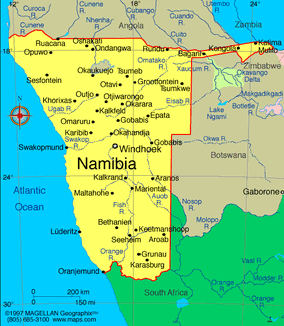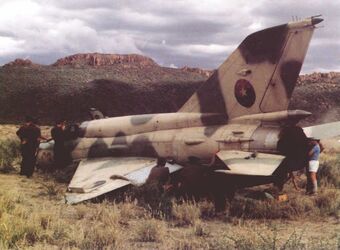
Namibia
The Namibia Bush War was a conflict fought by Namibia and components of the New Commonwealth against Communist insurgents supported by Angola and Cuba. While the war began in Namibia it would eventually involve Commonwealth forces entering Angola itself. The war began with Commonwealth intervention in Namibia in 1983 and ended in 1987 with the defeat of the Communists.
History[]
In World War I, South Africa conquered German territory in South West Africa on behalf of the British Empire and occupied that territory until the founding of the New Commonwealth required South Africa to grant the region independence. The new nation of Namibia installed a democratic political system and this has remained in place to the present day.
Following the granting of independence Namibia was offered membership to the New Commonwealth but this offer was declined. As an alternative however Namibia has remained a strong ally of the New Commonwealth with both military and economic trade links.
Phases of the Conflict[]
The war has been categorized as occurring over three distinct phases.
Phase 1: Intervention in Namibia[]

Communist airpower was unable to make a real impact on the war
The first phase of the conflict involved the military intervention against the Communist insurgency. This was the primary aim of the military involvement. It was hoped that with the New Commonwealth committing troops it would deter the Angolans (and their Cuban allies) from supporting the Communist insurgency further.
Angolan and Cuban air power attempted to stop this military intervention culminating in the Battle of Kavango but was hopelessly outclassed. Instead the support turned to logistical, training and political support. Nevertheless the New Commonwealth armies and Angolan/Cuban troops continued to clash in the north as they tried delivering these supplies. These clashes were kept as quiet as possible for fear that if it became public knowledge then it would worsen the situation.
Phase 2: Destruction of Angolan and Cuban ability to interfere[]
As 1983 gave way to 1984 the New Commonwealth leadership came to realize that more direct action was needed against the Angolans and Cubans who were effectively keeping the insurgency in Namibia alive. Still wishing not to widen the conflict (as had happened after the liberation of the Falklands) this phase initially involved cutting off Communist supply lines from Angola.

Nigerian Jaguar strike aircraft fought hard against the insurgents
This included the first air operations over Angola. Bridges, railway yards and air bases were the primary targets initially before the target list was expanded to cover things such as fuel storage depots and eventually command posts. The Communist defences in Angola proved stronger than had been anticipated and this lead to a reassessment of defence suppression tactics.
On the ground tank combat in the north was increasing which lead some to believe that the Communist forces were preparing a major land assault. In reality this never came but the clashes continued. The navies of the New Commonwealth went about enforcing an arms blockade at sea against Angola from June 1984 until the end of the war but supplies filtered in from neighbouring nations whose officials were easily corrupted.
By November 1984 the New Commonwealth had control over 75% of Namibia with the insurgency isolated in small pockets. Nevertheless they remained determined and continued the fight.
Phase 3: Expulsion of Cuban forces from Angola[]
By 1986 it was clear that the Angolans and their Cuban allies were dug in hoping to wear down the New Commonwealth's will to continue the war. Therefore the third and final phase saw New Commonwealth forces crossing the border to destroy the Communist war machine. This ended the conflict in 1987.
